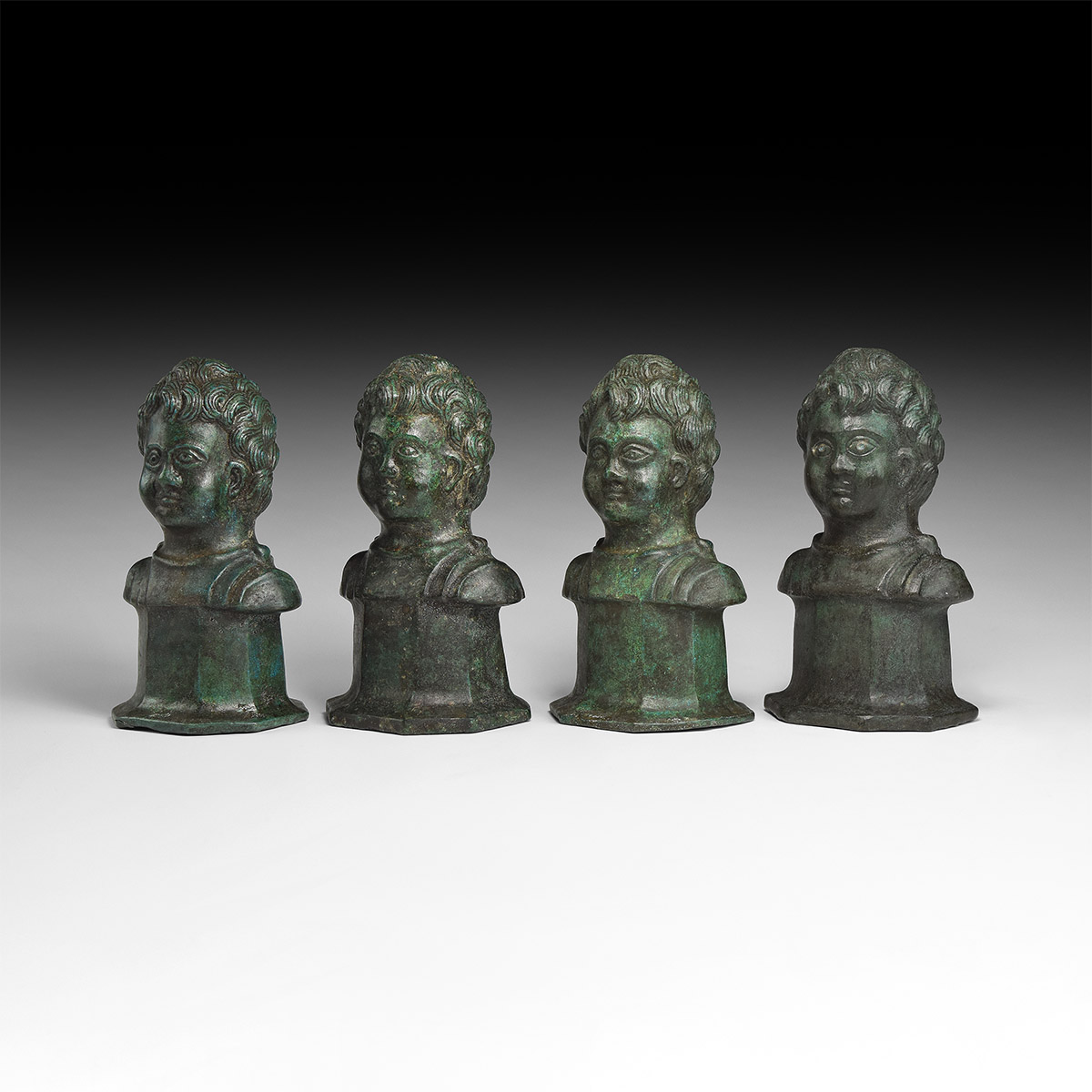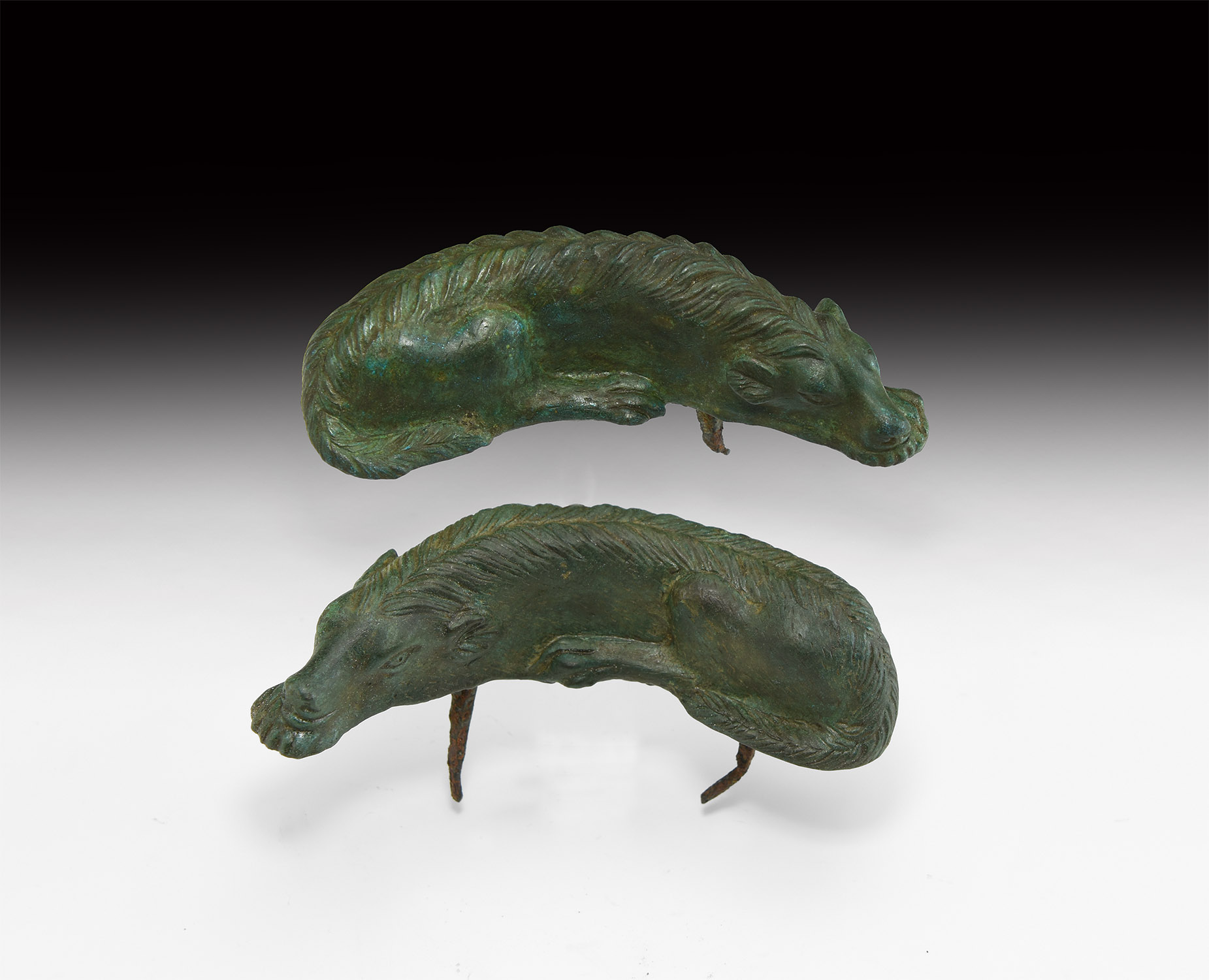ROMAN BRONZE CHARIOT MOUNT PAIR WITH EAGLE AND COBRAS CIRCA 2ND-3RD CENTURY A.D. 5 1/8 - 5 3/8 in. (2.1 kg total, 13-13.7 cm). Each protome composed of a gently tapering shallow octagonal body, the upper part formed as an eagle's head with semi-naturalistic hooked beak, eye and feather detailing, collar at the base of the neck decorated with crenelated borders; two upward curving arms terminating with stylised cobra heads; one with impact damage from a crash(?). [2] PROVENANCE: Private collection, Rosenheim, Germany, 1960s. Accompanied by an academic report by Dr Raffaele D'Amato This lot has been checked against the Interpol Database of stolen works of art and is accompanied by search certificate number no.11732-201194. LITERATURE: Cf. Boube-Piccot, C., Les bronzes antiques de Maroc, III, Les chars et l’attelage, Rabata, 1980, p.199, no.333, from Banasa; cf. Wenedikov, I., Le char thrace, Sofia, 1960, pp.153-201, pl.97, and Gudea, N., Porolissum. Un complex arheologic daco-roman la marginea de nord a Imperiului roman. II. Vama romana (monografie arheologica). Contributii la cunoasterea sistemului vamal din provinciile dacice, Cluj-Napoca, 1996, fig.31 (also Boube-Piccot, 1980, fig.10bis); a similar sheath had been found with the chariot of Nicomedia, and a similar, with open lateral rings showing serpents have been found in Thrace: three with a chariot from the tumulus of Doukhowa-Moghila, four with a cart from Ljubimec (Wenedikov, 1960, pl.55A, fig.190-192; p.40, no.150, pl.30, fig.107), four with the cart from Svilengrad, and a single isolated find has been discovered in the Burgos region. FOOTNOTES: These chariot fittings were usually elements surmounting the axle, a sort of sheath allowing the suspension from the body of the cart to the wagon box using belts. The chariot (currus) which these fittings adorned may have been used for transporting wealthy and aristocratic individuals, although most probably it was a tensa, i.e. a triumphal chariot or a ceremonial vehicle upon which images and symbols of divinities were placed. CONDITION
ROMAN BRONZE CHARIOT MOUNT PAIR WITH EAGLE AND COBRAS CIRCA 2ND-3RD CENTURY A.D. 5 1/8 - 5 3/8 in. (2.1 kg total, 13-13.7 cm). Each protome composed of a gently tapering shallow octagonal body, the upper part formed as an eagle's head with semi-naturalistic hooked beak, eye and feather detailing, collar at the base of the neck decorated with crenelated borders; two upward curving arms terminating with stylised cobra heads; one with impact damage from a crash(?). [2] PROVENANCE: Private collection, Rosenheim, Germany, 1960s. Accompanied by an academic report by Dr Raffaele D'Amato This lot has been checked against the Interpol Database of stolen works of art and is accompanied by search certificate number no.11732-201194. LITERATURE: Cf. Boube-Piccot, C., Les bronzes antiques de Maroc, III, Les chars et l’attelage, Rabata, 1980, p.199, no.333, from Banasa; cf. Wenedikov, I., Le char thrace, Sofia, 1960, pp.153-201, pl.97, and Gudea, N., Porolissum. Un complex arheologic daco-roman la marginea de nord a Imperiului roman. II. Vama romana (monografie arheologica). Contributii la cunoasterea sistemului vamal din provinciile dacice, Cluj-Napoca, 1996, fig.31 (also Boube-Piccot, 1980, fig.10bis); a similar sheath had been found with the chariot of Nicomedia, and a similar, with open lateral rings showing serpents have been found in Thrace: three with a chariot from the tumulus of Doukhowa-Moghila, four with a cart from Ljubimec (Wenedikov, 1960, pl.55A, fig.190-192; p.40, no.150, pl.30, fig.107), four with the cart from Svilengrad, and a single isolated find has been discovered in the Burgos region. FOOTNOTES: These chariot fittings were usually elements surmounting the axle, a sort of sheath allowing the suspension from the body of the cart to the wagon box using belts. The chariot (currus) which these fittings adorned may have been used for transporting wealthy and aristocratic individuals, although most probably it was a tensa, i.e. a triumphal chariot or a ceremonial vehicle upon which images and symbols of divinities were placed. CONDITION













Testen Sie LotSearch und seine Premium-Features 7 Tage - ohne Kosten!
Lassen Sie sich automatisch über neue Objekte in kommenden Auktionen benachrichtigen.
Suchauftrag anlegen